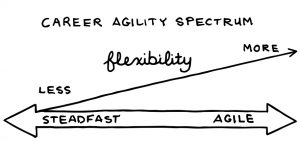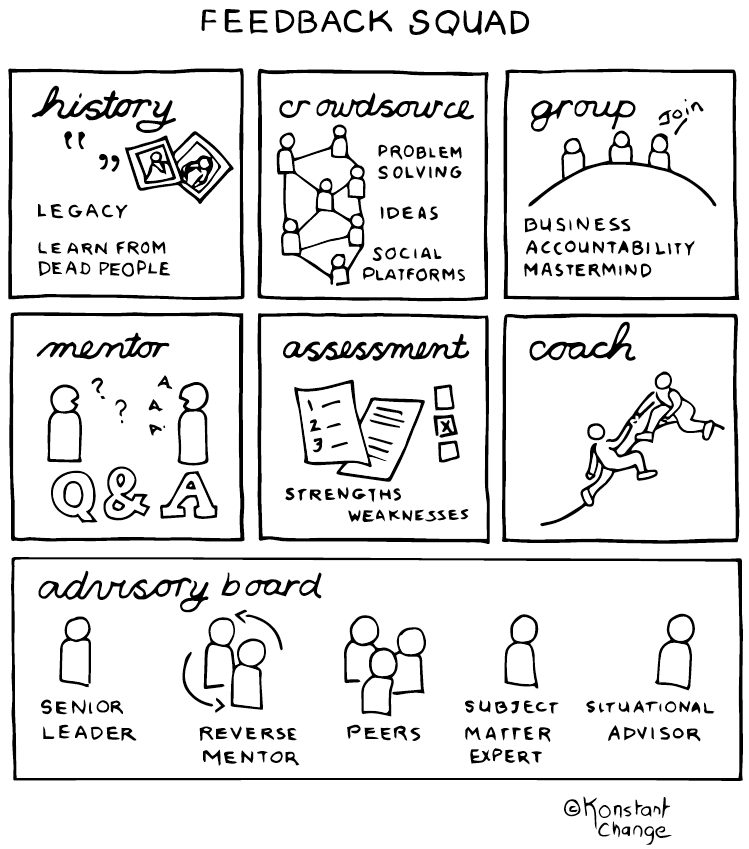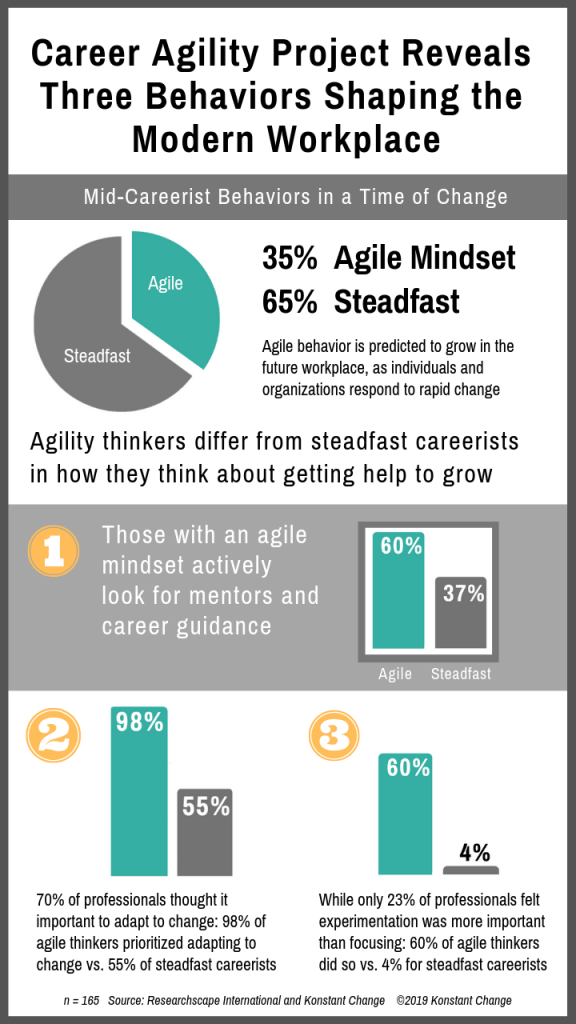
The mega project that launched primary research, my book, a business, and a series of blog posts is called the Career Agility Project. It also informed my ideas around creativity, growth, and happiness.
This article focuses on the research side of the project, along with the completion of the first infographic on this topic.
Career Agility Project Explained
As a side project, the process of exploration and writing Activate Your Agile Career took five years. The ambitious project included 1:1 interviews and hiring a firm to conduct survey research.
My goal was to better understand how some people respond to change, adapt, and progress in the workplace, while others falter when faced with change.
Why Agility?
While researching the topic of agility for the book, I took note of my personal career decisions and navigation. My approach included a hedging your bet strategy.
Just like a diversified financial portfolio, I managed my experience and skills portfolio, refining and optimizing it regularly.
My career became a platform for personal development, establishing a pattern of empowered agile behavior.

Identifying two types of career personalities, agile and steadfast, here are my findings. It’s important to mention that most of us fall somewhere between the extremities on the agility scale.
Higher agility scale scores correlate to a higher comfort level with uncertainty and change and lead to a state of continuous career progress.
While there are many behaviors recognized in the findings, there are three in particular highlighted in the infographic below.
Key Findings of The Career Agility Project 1:1 Interviews
Career Agility Behaviors:
- Example: Richard Branson, who consistently responds to change
- Create personal career rotations based on interests and drive, rather than depending on one career track
- Uncover new job descriptions in their industry and invent job descriptions to accommodate their skill sets and interests
- Adapt to change and are flexible, rather than avoiding change
- Possess and cultivate curiosity and resilience
- Believe in do-it-yourself career management, rather than relying on corporate development or human resources
- Follow and leverage industry trends to stay ahead of the curve for the next role
- Seek out advice and feedback from mentors (formal and informal)

- View career as a series of projects
- Optimize skills to grow professionally;seek out additional roles within the same company or reach out to a new company for the next stage of growth
- Value creativity, growth, and happiness in their life’s work
A/B test jobs on a regular basis, testing and measuring personal aptitude and interest with each new role - Pursue jobs and interests in parallel with the main job
- Build a personal work portfolio, fortifying skill sets with each new role
- Build and manage personal brands; communicate and package who they are, how they are different, and why it’s important
- Are highly productive workers who achieve happiness, gain access to new opportunities, and attain an impressive number of accomplishments
- May stay with one company for many years, switch jobs at strategic intervals, or start their own businesses
- Get bored with work that does not reflect a growth pattern
- Reinvent career paths, switching lanes from one career track to another
Steadfast Career Behaviors
- Example: Kay Whitmore of Kodak, who denied the digital trend in photography, an attitude that contributed to the company’s demise
- Pursue job loyalty, rather than adventure and risk
- Prefer predictable environments and circumstances
- Struggle with uncertainty and avoid change rather than adapt to change
- Work within their capabilities, rather than accumulate new skills
- Require structure and direction from organizations for a career path, rather than adopt self-direction
- Are often blindsided by trends that lead to uncertainty and job loss
- As Michele Wucker points out in her book, The Gray Rhino, this group ignores obvious dangers and does not act on them, in spite of the warning signs
- Typically lack a Plan B
- Stay at roles longer than agile careerists with intention of ensuring job security
Career Agility Survey Research Results
In addition to the 1:1 interviews I worked with Researchscape International to conduct survey research with people in the middle part of their careers.
As a result, Mid-Careerists in a Time of Change offers stats and behavior observations that helped me understand how workers navigate change and excel in the modern workplace.
The infographic below highlights three central points of the research.

Three Agility Behaviors to Consider for Workforce Development
In conclusion, there are three career agility behaviors to consider as you develop your workforce.
Agility thinkers differ from steadfast careerists in how they think about getting help to grow. For example, those with an agile mindset look for mentors and career guidance: 60% vs. 37% steadfast careerists.
While 70% of professionals thought it important to adapt to change, not everyone is doing it. 98% of agility thinkers
prioritized adapting to change, compared to 55% of steadfast careerists.
Only 23% of professionals felt experimenting was more important than focusing. Yet, 60% of agile careerists did so, however, compared to 4% of steadfast careerists.
What’s Next: Workforce Agility
While Activate Your Agile Career centered on the individual workplace perspective, The Happy Profitable Employees Project™ opens up a new area of research.
The project will include insights from business leaders on workforce development opportunities. I want to gain an understanding of how agility can support broader strategic goals in a rapidly changing workplace.
I am in the process of creating an article and report, weaving together employee and employer perspectives on agility and change.
If you are interested in the future of work, career development, the workplace, personal branding, workforce trends/ideas, agility, or how to cultivate happy profitable employees, subscribe to Marti’s 52 Ideas. For more details on career agility, check it out here.
You can also check out the best-selling book on Amazon, Activate Your Agile Career: How Responding to Change Will Inspire Your Life’s Work.
